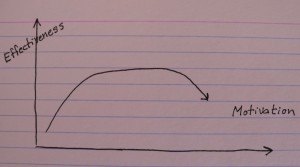by Dwayne Phillips
The vast majority of people need some type of motivation. There is, however, a limit to motivation that leads to effectiveness. Adding more motivation after this limit only leads to lesser effectiveness.
Here are a few posts on the MOI model from author and consultant Jerry Weinberg. The MOI model comprises three parts:
- Motivation
- Organization
- Information
This posts discusses Motivation.
Most people I know need some motivation to accomplish something. Some people are able to supply their own motivation. Things like fun, enjoyment, and accomplishment are enough motivation for themselves and these sources come from themselves.
There are other occasions when a manager or another person can supply the motivation.
Rah! Rah! Rah!
Well, maybe something a bit more subdued and sophisticated like,
There’s a big, fat bonus waiting if you finish on time
or
If you don’t finish on time, your fired
or even
I’ll love you if you do it right
Motivation works (the vast majority of the time in my experiences). The trouble is, there are limits to how much motivation works. This is part of Weinberg’s MOI model. Note the little graph below (you may have to click on it to see the whole thing).
At the left of the graph, you add motivation and everything works well – the effectiveness increases. This management stuff was child’s play. Well, it is until we reach the mid-point of the graph. We keep motivating – Rah Rah Rah – but the effectiveness stops climbing. Hmmm, let’s really cheer louder, but then we reach the right side of the graph and effectiveness starts to drop.
It must be time to fire the employees and bring in new ones – the type of people who respond to our good management practices or at least who will act like they are on the left side of the graph.
There seems to be only so much motivation that people can take. More than that, and they stop performing well. Adults just don’t take to all that cheering and such. I suppose adults realize that they have a job and they do their best. They don’t do any more than their best, and more cheering becomes annoying.
I recently heard an interview with Steve Young. He played football professionally at a Hall-of-Fame level. Someone asked him what abilities leave a player as he becomes older. Young didn’t reply “speed” or “strength” or any physical abilities. He replied that he first lost the ability to listen to a coach give a motivational speech.
Even with people who are outstanding in their field of endeavor, motivation only goes so far.
The key question for a manager is, “when do we hit the center of the graph?” There is a different answer for every different person and every different situation. The manager should observe his own motivational behavior and the other person’s response to that motivation.
Notice yourself.
Notice the other person.


0 responses so far ↓
There are no comments yet...Kick things off by filling out the form below.
Leave a Comment